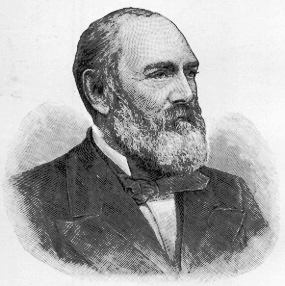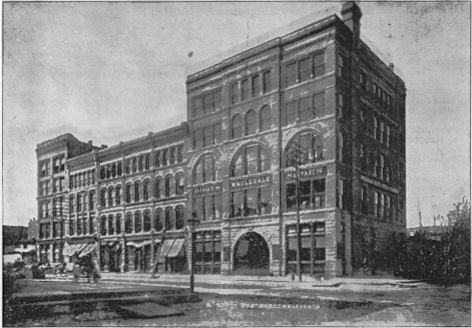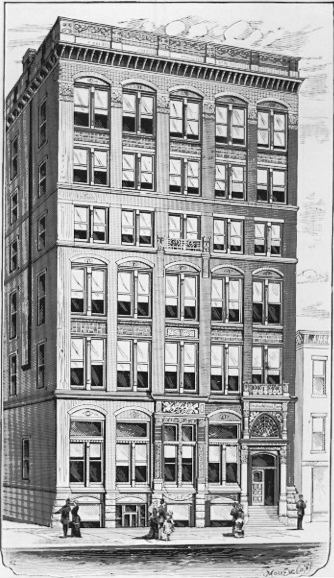|
OMAHA
ILLUSTRATED.
population. Such a growth in such a
period seems in the nature of the marvelous, yet there has
been little or nothing of the ephemeral boom-growth in it.
The increase has been achieved upon a substantial basis.
People who have come to Omaha have come to stay. The
investment of outside capital has been large, and the
enterprises it has furthered have furnished the sustenance
for the attendant elements of increase of population.
The
|
[General
Experience Estabrook has been a familiar figure in
Omaha affairs for over thirty years. He is one of
the oldest settlers. He was born in Lebanon,
Grafton county, New Hampshire, April 30, 1813,
where his parents lived until 1822, when the family
moved to Clarence (afterwards named Alden in honor
of Mr. Estabrook's grandmother of that name), a
town near Buffalo, N. Y. This was his home until
July, 1840. In the meantime he attended Dickinson
College, at Carlisle, Pa., also the law school
con-
|
|
nected with Marshall College, at Cham-
bersburg, Pa., where he graduated and was admitted
to the bar. He then continued his studies at
Brooklyn, N. Y., part of his time being taken up
with the duties of a clerkship in the navy yard at
that place. The young lawyer then removed to
Buffalo, N. Y., and began the active practice of
his profession, remaining one year, at the end of
which time he went to Geneva Lake, Wis., where he
attended the first term of court of Walworth
county. He practiced there until 1855. In 1851 he
was elected Attorney General of Wisconsin and held
the office two years. He was active in public
affairs and was a member of the Constitutional
Convention of 1848, in which
|

GEN. EXPERIENCE ESTABROOK.
|
he took a prominent part, especially on the
suffrage article, an amendment to which, offered by
him, enabled the colored man to vote before the
war. In 1849 he was elected to the Legislature of
Wisconsin. He came to Nebraska in 1855 as United
States Attorney, appointed by President Franklin
Pierce, and he held the office for four years and
nine months. In reaching here the party was obliged
to cross the river on the ice between Council
Bluffs and Omaha. This was on Monday, January 23,
1855, and the attempt was so hazardous that two
men, Palmer, of Council Bluffs, and Joseph Paddock,
of Omaha, in carrying a trunk between them, broke
into the channel and narrowly escaped drowning.
At
|
|
the first term of the court in the Territory of
Nebraska in the spring of 1855, General Estabrook
was the only member of the bar in the Territory,
recognized as such by the court, on account of his
official position, and upon his motion the first
bar was admitted to practice; so that it may be
said almost literally that Mr. Estabrook is the
father of the Nebraska bar. In July, 1859, he
accompanied the "Pawnee Expedition" up the Elkhorn,
attacking the Indians at what is now Battle Creek.
In that expedition Gov. Samuel W. Black was
commander-in-chief with the present governor,
General Thayer, in direct command. Mr. Estabrook
was a member of General Thayer's staff as Adjutant
General. Major General Samuel R. Curtis was also
one of the staff officers. On his return from this
expedition he ran for delegate to Congress, and was
elected, but in a contest before the House was
unseated in favor of Samuel G. Dailey, the
Republican nominee. Mr. Estabrook served, however,
through one session until June, 1860. He was
appointed by the Governor in 1866, to codify the
State laws, and was selected by the public printer
to superintend the publication and prepare the
index. This required his spending the summer in
Chicago and he embraced the opportunity to publish
a form book, called Estabrook's Forms, a valuable
legal work which, unfortunately, was nearly lost to
the profession -- the entire edition, with the
exception of a few books, being destroyed by fire.
The following year he was appointed district
attorney of this district, which office he held
from 1867 to 1869. In 1871 he was chosen a member
of the Constitutional Convention, and the same year
was employed by the board of managers as counsel to
aid in the impeachment of Governor David Butler,
who was found guilty and turned out of office.
General Estabrook was married at Geneva Lake, Wis.,
April 14, 1844, to Miss Caroline Augusta Maxwell,
daughter of Colonel James Maxwell, a pioneer of
Wisconsin. She was born in Tioga county, Pa. They
have two children, the eldest, Caroline Augusta,
now married to Col. R. C. Clowry, general
superintendent of the Western Union Telegraph
Company. Henry Dodge Estabrook, a son, is now
practicing law in this city.]
|
percentage of that which is termed "floating population," in
Omaha is very small. There is no lack of employment for
those devoted to almost any avocation, and the prosperity of
the people is uniformly great. This much having been said of
the community in common
[68]
|


